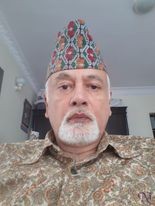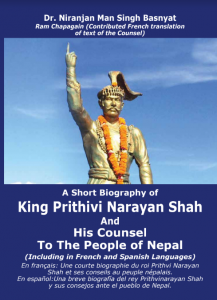Dr. Niranjan man Singh Basnyat, Kathmandu, Nepal

Political Scene in Northern India (Bengal, Bihar and Orissa)
During the reign of King Prithvi Narayan Shah, many events were unfolding in neighboring countries. The East India Company was gaining ground in northern India, including Bengal and Bihar. The Company was primarily established by the British Government to exploit opportunities for trade in the East, particularly in South Asia and South East Asia.
Alivardi Khan was the Nawab of Bengal, Bihar and Orissa when King Prithvi Narayan Shah ascended the throne of Gorkha on 3 April 1743. Alivardi Khan had killed his own Nawab Sarfaraz Khan to overthrow him while he was his deputy in 1740 at the battle of Giria. From 1741 to 1748, Marathas had become powerful in the south and attacked Bengal six times at the time of Nawab Alivardi Khan and he successfully opposed them all. Later he signed an agreement with Marathas led by General Raghunath Rao in 1751 and ceded a large territories of Orisaa. Alivardi Khan ruled till 1756.
The East India Company’s victory at the Battle of Plassey (also called Palashi) in 1757 changed the political situation in Bengal. It quickly defeated the opposition of Bengali ruler Nawab Siraj ud-Daula, believed to be also supported by the French.
Mir Jafar, who was the General of the Nawab, sided with the British in greed of becoming Nawab himself. Calcutta was recaptured by the Company forces commanded by Robert Clive and Admiral Charles Watson on 2 January 1757. The Hindu bankers and the army were against their own ruler Nawab Sirāj ud-Daula and he was betrayed by their treachery at Plassey.
Finally, on 23 June 1757, the Company’s army was successful in defeating them. Clive, with only a small force of 3,000, was able to conquer the Nawab’s army of 50,000 in the battle of Plassey. Nawab fled to Mursidabad and soon after he was arrested and executed. After this victory, the Company started taking full charge of the territories it controlled and even began to tax people’s property. This was the culmination of the British control in northern India and weakening of the power of Mughal Emperor in Delhi under whom the Nawabs were ruling.
Mir Jafar got his rewards of his treachery as nominal Nawab in Bengal apparently with British support. British Company official Henry Vansittart stated that Mir Jafar should be replaced by his son-in-law Mir Qasim because Mir Jafar could not control the situation as was desired by the British. Mir Qasim had married Fatima Begum, daughter of Mir Jafar.
In October 1760, the company overthrew Mir Jafar and appointed Mir Qasim as Nawab. He remained in that position till 1763. Later Mir Qasim had differences with the British and fought against the Company troops in 1763 in Patna and killed several British officials. Mir Jafar was again appointed as Nawab in 1763 by the British. Mir Qasim did not accept that. Then he fought the battle of Buxar, which was also supported by the troops of Shuja ud-Daula of Avadh and Emperor Shah Alam II. However, Mir Qasim lost that important battle in 1764. Then Mir Qassim left for Delhi and he died in Kotwal near Delhi in abject poverty on 8 May 1797.
As has been already mentioned above, Mir Qasim had sent his troops under the command of Gurgin Khan to fight against Gorkhalis on the request of King Digbandhan Sen in Makawanpur in January 1763. He was badly defeatedly by the Gorkhalis in that battle.
The East India Company became a very powerful force ignoring Mughal Emperor Shah Alam II of Delhi. Mir Jafar, however, remained Nawab until his death on 5 February 1765. He died of leprosy and is buried in Jafarganj cemetery in Murshidabad. Mir Jafar has become synonymous with betrayal in the history books.
The colonial forces of the East India Company applied the principle of “divide and rule” very successfully in Bengal, Bihar, and Orissa. In the same year in 1765, Robert Clive became the first British governor of Bengal until 1767 and thus a dual government was formed in Bengal from 1765 to 1772 under Clive’s leadership. Thus, the East India Company had also formally gained the Diwani rights of Bengal, Bihar, and Orissa from Emperor Shah Alam, which were granted to them so that they could collect taxes and decide on the civil cases. Thereafter, all subsequent Nawabs of Bengal had become only a powerless titular head.

On the British side, after Robert Clive left in 1767 as Governor, Harry Verelst became Governor on 17 February 1767 and remained until 1769. Then John Cartier became Governor of Bengal till 1773. On 20 October 1773, Warren Hastings took over as Governor of Bengal. King Prithvi Narayan Shah has written a letter to him about the matter related to Chaudandi and Bijayapur of eastern Nepal.
The second son of Mir Jafar, Nazam Ud-Daula, became the Nawab of Bengal, Bihar, and Orissa on 5 February 1765 at the age of fifteen. He suffered from fever after attending a Party given in honour of Governor Robert Clive at Murshidabad fort in 1766. He died on 8 May 1766. He was succeeded by his younger brother Nazim Nazabat Ali Khan, also known as Saif Ud-Daula as the Nawab. He ruled until his death by smallpox towards the end of February 1770. He was succeeded by his brother Ashraf Ali Khan who also died of smallpox within two weeks on 10 March. At that time, 63,000 people had died of the smallpox epidemic in Bengal. Mir Jafar’s other son Mubarak Ali Khan, better known as Mubarak Ud-Daula, became the Nawab on 21 March at the age of 12.
Mubarak Ud-Daula ruled until his death in 1793. In the same year, the East India Company took control of entire Bengal, Bihar, and Orissa from the Mughal Emperor’s suzerainty. King Prithvi Narayan Shah had already died in 1775.
Political Situation in Tibet and China:
At the time of reign of King Prithvi Narayan Shah (1743-1775), Emperor Qianlong had been ruling since 1735 in China. He was the sixth Emperor from the Qing (also called Manchu) dynasty and he ruled until 1796. He ruled for 60 years and abdicated the throne in favour of his son Jiaqing in 1796. He died in 1799. He had conquered Manchuria, Turkey, and Tibet. They were annexed to China during his glorious reign.
There was practically no problem between Gorkha and China. This was mainly due to the massive Himalayan range that divided the two regions and thus limited interactions and chances of conquest.
Nepal’s interaction was more with Lhasa than with Beijing at that time. In Lhasa, there was the period of 7th Dalai Lama who had some political power. The real power was with two Ambans (High Officials or Representatives) appointed by the Chinese Emperor Qianlong. Nepali traders mostly used to sell their goods in Lhasa and return with salt and wool. Malla kings of the Kathmandu valley were circulating their coins in Tibet for trade.
After the victory over Malla kingdoms, King Prithvi Narayan Shah tried to solve the problem with the good quality of these coins but he was unsuccessful. He wanted to circulate his pure silver coins instead of mixed coins of Malla kings.
King Prithvi Narayan Shah did not want to have any problems with Tibet which could have caused displeasure to the Chinese Emperor. It was evident from the fact that he had given instructions on 5 October 1774 to his military commander, Kazi Abhiman Singh, and his assistants not to enter into Tibet even by some inches as it could cause problems at the time of Gorkhali operations against Sikkim. But later, Regent Bahadur Shah and Kazi Damodar Pandey did not abide by this instruction and this led to war with Tibet and China in 1788-1791.
Chinese Emperor Qianlong had appointed two Ambans (high officials or representatives) in Tibet. Gorkha, and later Nepal used to communicate through these Ambans if there were any official communications required with China.
It is admirable that King Prithvi Narayan Shah had already accomplished the gigantic task of the unification (first phase) of the country by 1769.
When we study world history, it was even before the War of American Independence (1775-1783) and French Revolution (1789). Then he also conquered the eastern states of Chaudandi and Bijayapur in 1774 just before his death. The East India Company was making big headway in the victories of territories in India and it was on its way to become a world power.
Given the situation of that time, how it was possible to create or unify a country from a small poor state of Gorkha with 12,000 households to a much large and geographically diverse country?
King Prithvi Narayan Shah had imagined and executed three basic things, which Mahesh C. Regmi summarizes:
First, it had the leadership with a vision, the vision of bringing most, if not the whole, of the Himalayan region under it. That leadership, despite the narrow confines of a hill state, responded with remarkable resourcefulness and imaginativeness to the formidable challenges of conquering and administering a far-flung empire. Second, the state of Gorkha was able to organise a standing army of a significant size. Last, more territories meant more people, hence more tax-payers, more fighting men, and more porters and labourers. They also meant more natural resources such as agricultural lands, forests and mines, hence more sources of revenue and more supplies and provisions. Territorial expansion was thus a self-propelling process, generating per se the resources needed for further expansion.
The Counsel:
King Prithvi Narayan Shah is believed to have fallen sick in the last week of December 1774.
Then he summoned everybody to his palace in Nuwakot and gave his Counsel in order to safeguard the nation for future generations. He died on the morning of 11 January 1775. This Counsel was believed to have been given by him to his courtiers and people at a palace named “Rangmahal” which was built in 1766 in the plains of Taadi river in Nuwakot. His Counsel to courtiers, leaders, and citizens of Nepal is found in the following pages.
# Next issue to begin with: King Prithvi Narayan Shah’s Counsel (Upadesh): Ed. Upadhyaya.
#Articles appearing in Telegraphnepal.com could also be seen in our new news portal Telegraph News (https://dev-telegraph-news.pantheonsite.io): Editor. Upadhyaya.
